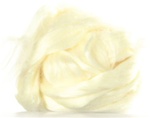One of the first things I learned about this fiber commonly called Soysilk is that Soysilk is a name brand of soy fiber. However Soy Silk can be used(i think). Anyway onto the good stuff.
Henry Ford had a great interest in the soybean as the next great crop that would bring industry and farmers together(little did he know how right he was). Much of his food and fiber, and soy ideas were laughed at. He became famous for cars but his interest in soy fiber carried into the vehicles(seat coverings etc). Robert Allen Boyer worked with Ford to help produce and refine the fiber. Two acres of land will produce 400 pounds of soybean protein.” Boyer’s fiber resembled a soft wool; it was loose and fluffy, white to tan in color with medium luster, and had a soft, warm feel, natural crimp, and high degree of resilience. It had 80% the strength of wool, took the same dyes, had good elongation, and did not wet as easily as wool. It could be used for upholstery in cars, filling in felt hats, or clothing. At the New York World’s Fair in 1939, Ford had a display featuring a machine spinning soy protein fibers. (Note that term “spinning” is used by the textile industry for production of synthetic fibers like rayon; actually it is an extrusion/coagulation process.) By 1938 Ford sported a necktie (his favorite 75th birthday present) in which half of the material was soybean “wool.” Three years later he made a public appearance in his treasured “soybean suit” (made of 25% soybean “wool” and 75% sheep’s wool) with which, reported the Detroit Times (1941), he was “as delighted as a boy with his first long pants,” Both he and soybeans garnered huge amounts of free publicity from the event. Boyer had made his wife a coat of the same material in 1940. In that same year Boyer, only 31, headed a staff of 25 research assistants whose average age was only 24. For his many outstanding achievements, the US Chamber of Commerce voted Boyer the Outstanding Young Man of 1940 (Garfield 1941).
However, problems with production, costs and a lack of commercial interest did not make it a viable alternative. With so many more easily available fabrics on the market no serious interest was taken in creating soy clothing, until Mr Li Guanqi of China.
In 1999, Mr Li was successful in creating a soft, smooth, drapy, comfortable fabric similar in feel to cashmere. In fact it is often referred to as vegetable cashmere. Soy silk is an eco-friendly fiber made from tofu manufacturing waste. The fiber is made entirely of soy protein (which is a by-product from the manufacture of tofu).
They take these cakes called Okara and add bioengineered polymers( not sure what they mean by that)
quick detour: bio engineering-is any type of engineering–for example, mechanical engineering–applied to living things.
Polymer-A substance that has a molecular structure built up chiefly or completely from a large number of similar units bonded together.
I couldn’t seem to find anything on what exactly the bioengieered polymer was.
After the soy is liquid it is put thru spinnerets and dried. That is how they make it into natural colored fiber for dying and spinning.
Here is some soy fiber.
Tags: animal rescue, animals rescue maine, fiber processing, soy fiber spinning, soy fiber yarn, soya fiber, spinning soy, spinning soy silk, spinning wool by hand, vegan spinning fiber, vegan spinning wool, vegetarian spinning fibers










